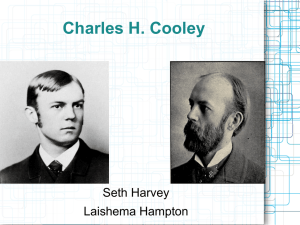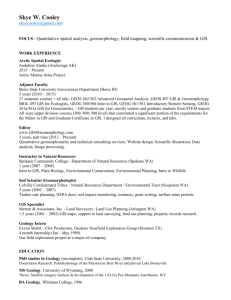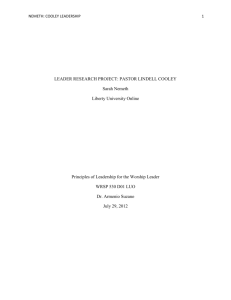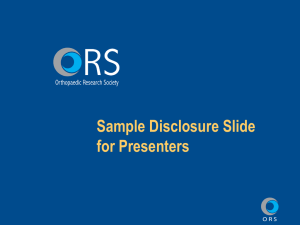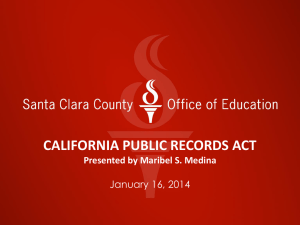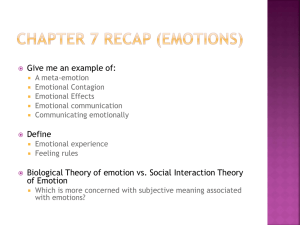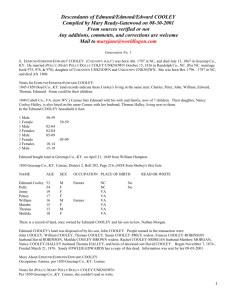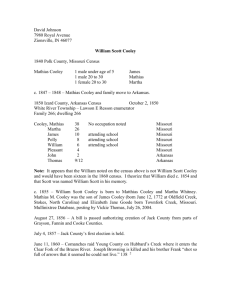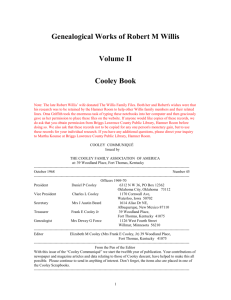Cooley LLP, “Reg. FD in 2011,” - National Investor Relations Institute
advertisement
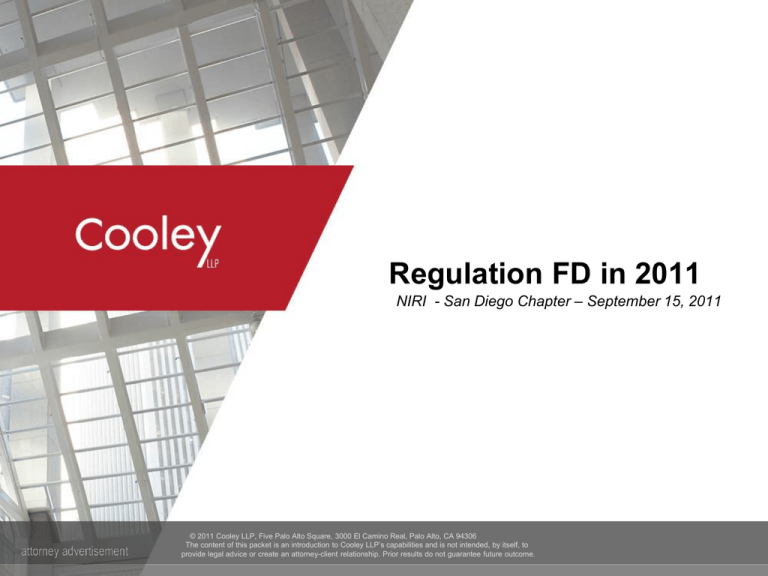
Regulation FD in 2011 NIRI - San Diego Chapter – September 15, 2011 © 2011 Cooley LLP, Five Palo Alto Square, 3000 El Camino Real, Palo Alto, CA 94306 The content of this packet is an introduction to Cooley LLP’s capabilities and is not intended, by itself, to provide legal advice or create an attorney-client relationship. Prior results do not guarantee future outcome. Regulation FD Refresher Designed to prevent “selective disclosure” of material non-public information (oral or written) to analysts or institutional investors prior to disclosure to the general public Rules took effect on October 23, 2000 Overlaps with Rule 10b-5 obligations 2 www.cooley.com Regulation FD Refresher Whenever an issuer, or any person acting on its behalf, discloses any material nonpublic information regarding that issuer or its securities to any person described in paragraph (b)(1) of this section, the issuer shall make public disclosure of that information as provided in Rule 101(e) Simultaneously, in the case of an intentional disclosure; and Promptly, in the case of a non-intentional disclosure Material non-public information disclosed to certain categories of outsiders by certain corporate insiders must also be disclosed to the general public Information Must be material Must be non-public 3 www.cooley.com What is Material Information? If there is “a substantial likelihood that a reasonable shareholder would consider the information important” in making a decision to buy or sell the securities, the information is material SEC says it will not second guess judgment calls of materiality if the judgment was made in good faith and is not clearly incorrect A specific piece of information should not be material if: Unbeknownst to the issuer It helps an analyst complete a “mosaic” of information that when taken together with other information lawfully received, is material Determining lack of materiality is very difficult to predict in advance If disclosure is followed by significant market activity, movement in stock price or revision of expectations, heavy burden on issuer to demonstrate it resulted from piecing together a “mosaic” 4 www.cooley.com What is Material Information? Matrixx Lawsuit: In March 2011, the U.S. Supreme Court issued an opinion involving Matrixx’s lack of disclosure of reports that Zicam caused a loss of the sense of smell. The Court declined to adopt a “bright line” materiality standard based on the statistical significance of the risk. Standard remains whether a reasonable investor would have viewed the undisclosed information as having significantly altered the total mix of information made available. Companies can control what it is required to disclose, by controlling what its says to the market. 5 www.cooley.com To Whom Does Regulation FD Apply? Categories of insiders defined in Rule: Senior officers and directors Investor relations or public relations personnel, including IR and PR firms hired by the company Other employees or agents who regularly communicate with outside investors or securities market professionals 6 www.cooley.com To Whom Does Regulation FD Apply? Categories of outsiders defined in Rule to whom selected disclosure may not be made: Broker dealers and securities market professionals, including sell-side analysts Investment advisors, institutional investment managers and buy-side analysts Investment companies, hedge funds Any stockholder, if the disclosure is under circumstances in which it is reasonably foreseeable that such holder will purchase or sell the issuer's securities on the basis of the information 7 www.cooley.com Persons or Entities Excluded From Regulation FD Persons who owe a duty of trust to the issuer such as an attorney, investment banker or accountant Persons who expressly agree to maintain the disclosed information in confidence 8 www.cooley.com Methods of Public Disclosure Furnish or file a Form 8-K disclosing the information Another method (or combination of methods) of disclosure that is reasonably designed to provide broad, non-exclusionary distribution of the information to the public including: Press releases Exchange Act Reports (10-Q’s, 10-K’s) Conference calls open to the public (advance notice required) Posting information on Company website generally is not, by itself, sufficient public disclosure 9 www.cooley.com Situations Where Regulation FD Will Apply Analyst conference calls Individual meetings or calls with analysts or investors Industry or investment banking conferences Roadshows for private placements, PIPES, 144A and Regulation S offerings 10 www.cooley.com SEC Enforcement Actions From 2002 to 2005, the SEC brought seven Reg FD enforcement actions Twice against Siebel Systems From 2006 to September 2009, the SEC brought only one Reg FD enforcement action 11 www.cooley.com SEC Enforcement Actions Recent Enforcement Actions Christopher Black (American Commercial Airlines, Inc.); September 2009 – weekend email to analysts that earnings would be lower than guidance a few days earlier; company not pursued. Presstek/Marino; March 2010 – call with registered investment adviser two days before end of quarter; company paid $400,000 fine and implemented remedial measures. Office Depot; October 2010 (actions relate to 2007) – concerned that analyst estimates were too high considered issuing a press release, but internal estimates were incomplete directed employees to conduct one-on-one calls with analysts referring to recent public statements of comparable companies that cautioned the impact of the slowing economy CFO assisted in preparing talking points for calls At least one analyst expressed concern over lack of press release six days after calls to analysts, 8-K filed to disclose the earnings would be negatively impacted due to continued soft economic conditions (7.7% drop in price over that period) Company paid $1 million; CFO and CEO each paid $50,000 12 www.cooley.com Responsive Actions Office Depot hired a new General Counsel and Vice President of Investor Relations in July 2007 and significant changes were made Developed written policy on Fair Disclosure to and communications with the investment community Provided extensive Regulation FD training to all approved spokespersons Instituted mandatory “two-person rule” for all contact with the street Developed call log for all one-on-one conversations and group meetings Instituted a “total blackout” quiet period four weeks prior to quarterly and eight weeks prior to full-year earnings announcements 13 www.cooley.com Responsive Actions Office Depot changes (continued): Created “Investor FAQ” section on website to address topical issues Established policy to not update or affirm any financial outlook following earnings calls unless 8-K was filed Insisted that all industry conference presentations be webcast Established policy that any inadvertent disclosures, regardless of perceived materiality, must be reviewed with General Counsel 14 www.cooley.com General Observations Must be consistent at all times Watch tone, body language, slight wording differences Consult counsel One on ones, private meetings are areas of focus Balance the practicalities Review written disclosure/Reg FD policies Refresh training on a regular basis 15 www.cooley.com Who is authorized to speak for the Company? Identify individuals who are authorized to speak on behalf of the company. All inquiries should be directed to these individuals. Provides consistent messaging. Control flow/timing of disclosure. Protect confidential information (e.g., customer relationships, R&D). Limit liability. Spokespersons should understand Reg. FD, but also: What information the company discloses (and what it does not) When to use forward looking statement disclaimers. When to use GAAP / non-GAAP reconciliations. 16 www.cooley.com Tips for Dealing with One-on-Ones Hold conversations shortly after a public release of information and, if applicable, related conference call when the universe of material nonpublic information is smaller Avoid conversations during black-out periods Establish ground rules for questions that will not be answered Company reps should be fully informed about what information is publicly available Consider debriefing IR or counsel immediately after one-on-ones Consider keeping log of one-on-one conversations 17 www.cooley.com Tips on Guidance Establish policy as to whether you will update guidance communicate this policy when asked to update (i.e., “our policy is to not update guidance given in our conference calls”) If you intend to update guidance, you should issue a press release prior to the conversation If material, you can’t confirm guidance currently in a one-on-one can’t say “nothing has changed” or “we remain comfortable with our prior guidance” as this constitutes a new statement 18 www.cooley.com Analyst Conferences and Roadshows No material non-public information in presentation and breakout sessions otherwise must disclose the information publicly in advance, e.g., file the presentation on an 8-K and post on website Rehearse presenters Scrub slides for material non-public information Once a decision is made to disclose information, later developments must be considered in light of Matrixx; subsequent information that is not disclosed must not significantly alter the "total mix" of information 19 www.cooley.com Analyst Conferences and Roadshows Some companies are insisting that they be allowed to webcast their presentations for full access Sponsors of these meetings are generally offering webcast services, but it is the company’s responsibility to provide notice to interested investors and media that the live webcast is being conducted, and how to access it Even if the company does not plan to provide any new material information, the webcast is your insurance policy against allegations of selective disclosure if during a webcast Q&A a material disclosure occurs 20 www.cooley.com Communications with Employees If employees leak information, the company may need to respond publicly. If employees trade while aware of the information, it could result in insider trading liability and/or negative publicity. If sensitive information is disclosed internally: Indicate that information is confidential and label documents appropriately - confidential / for internal use only / do not forward outside the company. To the extent possible, limit the amount of information disclosed – what do employees need to know to understand what you are communicating? If necessary or appropriate, restrict trading under the insider trading policy. 21 www.cooley.com
